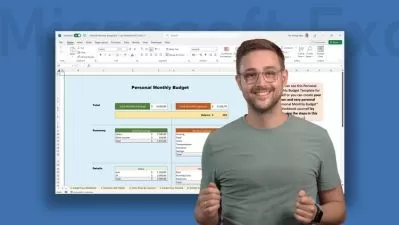Advanced Budgeting and Financial Analysis: Banking Sector
EDUCBA Bridging the Gap
6:34:00
Description
Unlock the fundamentals of consumer and commercial banking, budgeting, and financial analysis for financial management.
What You'll Learn?
- Banking Fundamentals: Key concepts in both consumer and commercial banking, including interest-bearing accounts, personal loans, commercial loans.
- Budgeting Basics: Essential budgeting skills to effectively manage finances, understand budget structures, and apply strategic planning.
- Financial Statements Analysis: How to interpret and analyze balance sheets and income statements to assess an entity’s financial position, covering assets.
- Dividend and Capital Analysis: Concepts related to shareholder returns, dividends, share buybacks, and the implications of various corporate actions.
- Scenario Analysis: Practical tools for analyzing various financial scenarios, understanding economic indicators, and using forecasting simulations
- Consolidated Budgeting Techniques: Building comprehensive budgets that encompass revenue, cost of sales, gross profit, and other expenses.
Who is this for?
What You Need to Know?
More details
DescriptionThis course provides a comprehensive introduction to the foundational elements of banking, budgeting, and financial statement analysis. Beginning with the essential aspects of banking and budgeting, the course then dives into consumer and commercial banking services, financial advisory concepts, and detailed financial statements. You’ll explore practical applications and financial decision-making tools designed to deepen your understanding of how banking and budgeting support strategic financial planning.
Section 1: Introduction
The course starts with an introductory overview, laying out the objectives and key learning points. Students will gain a sense of the course’s structure and the importance of mastering banking and budgeting principles for financial clarity and control.
Section 2: Banking and Budget Basics
This section covers the fundamentals of banking and budgeting. Lectures focus on foundational banking concepts and an in-depth look at budgeting practices, equipping students with techniques to manage and plan their finances more effectively.
Section 3: Consumer Banking
In this section, students explore consumer banking products such as interest-bearing accounts, personal loans, and home and vehicle loans. Practical insights help students understand how these products work and their implications for personal financial management.
Section 4: Commercial Banking
The course then transitions to commercial banking, covering essential business banking tools like commercial loans, working capital management, payroll services, and bank guarantees. Students will learn how these products help businesses manage liquidity, support operations, and ensure business continuity.
Section 5: Advisory and Services
This section introduces students to wealth management and trade finance. It covers wealth management strategies and trade and fund services that banks provide, focusing on how these services can support both personal and commercial clients in achieving their financial goals.
Section 6: Balance Sheet
In this detailed look at balance sheets, students explore the structure and elements of a balance sheet, learning how assets, liabilities, and equity interact. This hands-on section helps students read and analyze balance sheets to gain insights into a company’s financial health.
Section 7: Income Statement and Funding Gap
Moving into income statement analysis, this section guides students through understanding revenue, expenses, and profitability. It also examines the concept of the funding gap, giving students tools to analyze income flow and operational costs.
Section 8: Reserves and Provisions
This section explains how banks and businesses manage reserves and provisions. By understanding these financial cushions, students learn how companies protect themselves against future uncertainties and prepare for potential liabilities.
Section 9: Consolidated Budget
Students dive into consolidated budgeting, including revenue, expenses, and cost of sales. The lectures detail how to build a master budget that combines various aspects of financial management into a cohesive plan, ensuring students can oversee overall profitability and expense control.
Section 10: Scenario Analysis
This section explores growth rate scenarios, economic indicators, and forecasting simulations. With practical tools for scenario analysis, students learn to assess financial stability under different market conditions and create adaptable financial strategies.
Section 11: Recap
The course concludes with a comprehensive recap of the key lessons and strategies covered. Students consolidate their learning, ready to apply their new financial management skills in real-world contexts.
Conclusion
By the end of this course, students will have mastered essential skills in banking, budgeting, and financial statement analysis. Equipped with these tools, they’ll be well-prepared to make sound financial decisions in both personal and professional contexts, confident in their ability to navigate the complexities of financial management.
Who this course is for:
- Aspiring Finance Professionals: Students or early-career individuals interested in a career in finance, banking, or financial advisory will gain practical knowledge and foundational concepts.
- Small Business Owners and Entrepreneurs: Those managing their own businesses will benefit from insights into banking services, budgeting basics, and financial statements to better manage their finances.
- Individuals Interested in Personal Finance: Anyone looking to understand consumer banking, budgeting, loans, and wealth management will find practical advice and tools to apply in their own financial planning.
- Non-Finance Professionals Seeking Financial Literacy: Those in non-financial roles who want a better understanding of budgeting, balance sheets, income statements, and financial analysis to contribute more effectively to their organizations.
This course provides a comprehensive introduction to the foundational elements of banking, budgeting, and financial statement analysis. Beginning with the essential aspects of banking and budgeting, the course then dives into consumer and commercial banking services, financial advisory concepts, and detailed financial statements. You’ll explore practical applications and financial decision-making tools designed to deepen your understanding of how banking and budgeting support strategic financial planning.
Section 1: Introduction
The course starts with an introductory overview, laying out the objectives and key learning points. Students will gain a sense of the course’s structure and the importance of mastering banking and budgeting principles for financial clarity and control.
Section 2: Banking and Budget Basics
This section covers the fundamentals of banking and budgeting. Lectures focus on foundational banking concepts and an in-depth look at budgeting practices, equipping students with techniques to manage and plan their finances more effectively.
Section 3: Consumer Banking
In this section, students explore consumer banking products such as interest-bearing accounts, personal loans, and home and vehicle loans. Practical insights help students understand how these products work and their implications for personal financial management.
Section 4: Commercial Banking
The course then transitions to commercial banking, covering essential business banking tools like commercial loans, working capital management, payroll services, and bank guarantees. Students will learn how these products help businesses manage liquidity, support operations, and ensure business continuity.
Section 5: Advisory and Services
This section introduces students to wealth management and trade finance. It covers wealth management strategies and trade and fund services that banks provide, focusing on how these services can support both personal and commercial clients in achieving their financial goals.
Section 6: Balance Sheet
In this detailed look at balance sheets, students explore the structure and elements of a balance sheet, learning how assets, liabilities, and equity interact. This hands-on section helps students read and analyze balance sheets to gain insights into a company’s financial health.
Section 7: Income Statement and Funding Gap
Moving into income statement analysis, this section guides students through understanding revenue, expenses, and profitability. It also examines the concept of the funding gap, giving students tools to analyze income flow and operational costs.
Section 8: Reserves and Provisions
This section explains how banks and businesses manage reserves and provisions. By understanding these financial cushions, students learn how companies protect themselves against future uncertainties and prepare for potential liabilities.
Section 9: Consolidated Budget
Students dive into consolidated budgeting, including revenue, expenses, and cost of sales. The lectures detail how to build a master budget that combines various aspects of financial management into a cohesive plan, ensuring students can oversee overall profitability and expense control.
Section 10: Scenario Analysis
This section explores growth rate scenarios, economic indicators, and forecasting simulations. With practical tools for scenario analysis, students learn to assess financial stability under different market conditions and create adaptable financial strategies.
Section 11: Recap
The course concludes with a comprehensive recap of the key lessons and strategies covered. Students consolidate their learning, ready to apply their new financial management skills in real-world contexts.
Conclusion
By the end of this course, students will have mastered essential skills in banking, budgeting, and financial statement analysis. Equipped with these tools, they’ll be well-prepared to make sound financial decisions in both personal and professional contexts, confident in their ability to navigate the complexities of financial management.
Who this course is for:
- Aspiring Finance Professionals: Students or early-career individuals interested in a career in finance, banking, or financial advisory will gain practical knowledge and foundational concepts.
- Small Business Owners and Entrepreneurs: Those managing their own businesses will benefit from insights into banking services, budgeting basics, and financial statements to better manage their finances.
- Individuals Interested in Personal Finance: Anyone looking to understand consumer banking, budgeting, loans, and wealth management will find practical advice and tools to apply in their own financial planning.
- Non-Finance Professionals Seeking Financial Literacy: Those in non-financial roles who want a better understanding of budgeting, balance sheets, income statements, and financial analysis to contribute more effectively to their organizations.
User Reviews
Rating
EDUCBA Bridging the Gap
Instructor's Courses
Udemy
View courses Udemy- language english
- Training sessions 43
- duration 6:34:00
- Release Date 2025/01/23










